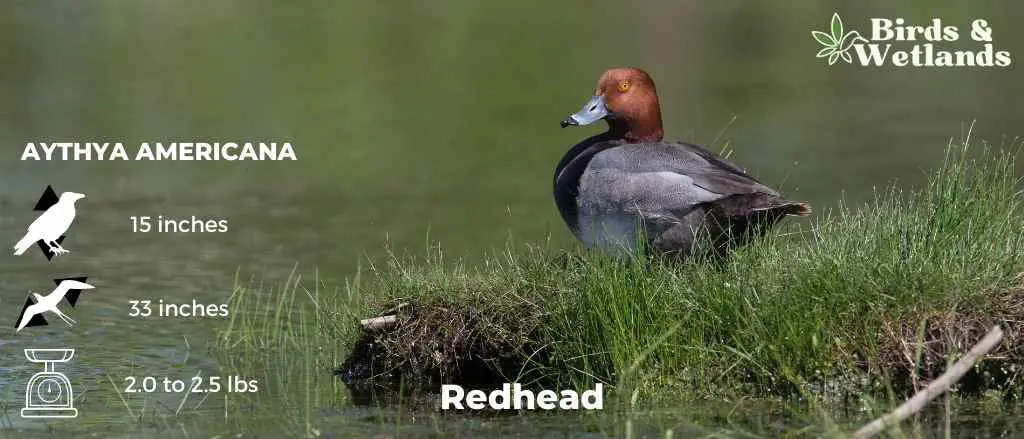The redhead duck (Aythya americana) is a medium-sized diving duck, easily recognizable by its rich chestnut-red head and bright blue bill.
The redhead is also known as the red-headed duck and the red-headed pochard.
This duck species belongs to the genus Aythya, which includes canvasbacks, ring-necked ducks, pochards and scaups.
Scientific Name: Aythya americana
Height: 37 cm (15 in)
Weight: 2.0 to 2.5 lbs
Wingspan: 84 cm (33 in)
Redhead Physical Description
The adult male redhead has a distinctive cinnamon-red head with a steep forehead that meets their bill at a sharp angle. It has a black breast and rear. The body itself is gray, while the bill has a bluish-gray hue and a black tip. The tail and legs of the bird is black.
Adult female redheads have a unique greyish-brown back, and flanks often flecked with white. Their wings are brownish-grey with darker tips on their primaries, and their underparts are brown on the breast and white on the belly.
The heads and necks of adult female redheads are yellowish-brown with a darker crown, pale bill base, and rear of the eye. They have a dark gray bill with a black tip.
Non-breeding males have brown heads instead of copper.

Listen to Redhead
Redhead Distribution & Range
During the breeding season, they inhabit intermontane regions across North America, including parts of northern Canada, British Columbia, Alberta, Saskatchewan, Manitoba and the Dakotas.
In the United States, tens of thousands of these ducks breed throughout Great Plains and the prairie pothole region of the Midwest and the wetlands near the Great Lakes.
In winter, these diving ducks migrate southward to warmer climates such as along the Gulf Coast, Laguna Madre in Texas, Mexico, Guatemala, Cuba, the Bahamas and the Caribbean. These areas provide ideal conditions for the species to survive during this time of year.
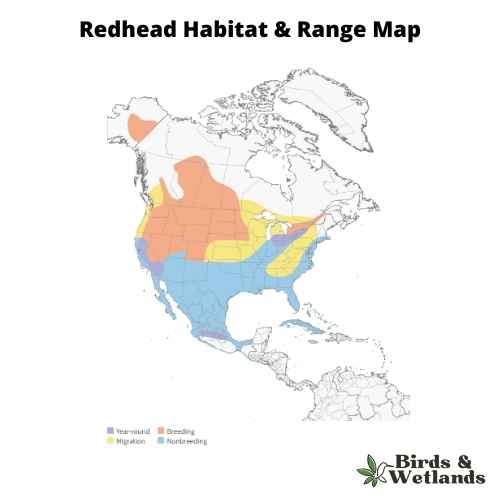
Redhead Habitat
The redhead is well adapted to wetland environments and can be found in various habitats within this ecosystem. It is typically found in shallow water, wetlands, and marshes. These areas provide the perfect habitat for the redhead duck to find food, as they primarily feed on aquatic invertebrates such as snails, clams, insects, wild rice, and pondweeds.
During the mating season, redheads prefer to nest in dense emergent vegetation or cattail marshes near large bodies of water. This gives them access to food and shelter while raising their young.
In the winter, large flocks of redheads and other ducks have often observed wintering near large lakes and saltwater bays.
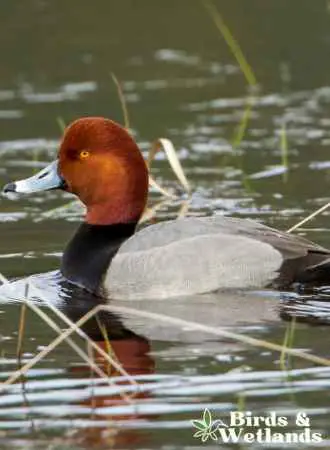
Redhead Feeding Habits & Diet
Redheads are omnivorous, meaning they will eat plants and animals as part of their diet. In the wild, they will feed on various aquatic plants, wild celery, water lilies, seeds, and grains. Occasionally, they eat aquatic insects, snails, and small fish.
This is a diving duck specially adapted to dive underwater to search for plants and animals to eat. They are skilled divers and can remain underwater for up to a minute while searching for food.
Redheads typically feed in the morning and afternoon, although they may also feed at other times if available. They are social birds and often feed in groups, with each duck taking turns diving for food.
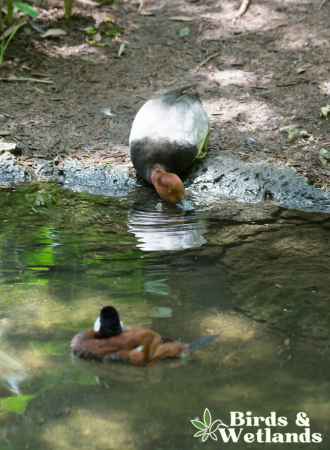
Redhead Nesting & Mating Habits
Redhead ducks are seasonally monogamous, meaning pair bonds only last until the current year’s egg-laying season. The birds need to find a new mate for next year.
Redheads breed with other redheads and sometimes with other species of diving ducks such as pochards, greater scaup and ring-necked duck. Some females lay their eggs into the nests of other birds such as the American bittern and Northern Harrier.
During the mating season, males will perform elaborate courtship displays to attract females. This may include swimming in circles, bobbing their heads, and emitting a cat-like call.
Once a female is attracted, the the two birds will mate, and the female will lay eggs in a nest she has built on the ground near the water. She makes the nest using grasses, feathers, and other plant material found in their environment.
The female will typically lay 7 to 14 pale olive to dull white eggs, which she will incubate for about 27 to 33 days. During this time, the male leaves the female to join other males to start molting.
During the breeding season, redheads often engage in the form of social parasitism known as brood parasitism. This behavior involves hens laying their eggs in the nests of other pochards, such as canvasbacks, ring-necked ducks, greater scaups and lesser scaups.
This parasitic behavior can reduce the hatching success of other pochard eggs, particularly those of the canvasback. Because of this relationship between redheads and other pochards, hybridization between species has been observed.
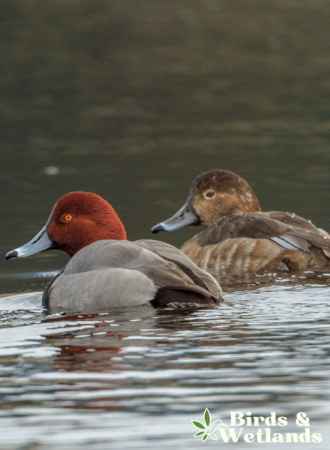
Redhead Threats & Conservation
Redheads are a unique species of duck native to North America and comprise a small portion of the continent’s overall duck population. In recent decades, their population has increased, with estimates now at over 1.4 million birds.
Redheads use semi-permanent and permanent wetlands for breeding, usually located in more remote areas and less affected by climate or human development.

Redhead Hunting
Hunting redheads is allowed in most states where they occur. However, it is subject to state and federal hunting regulations, including non-toxic shots, bags and possession limits. These limitations are in place to protect and maintain the redhead population. The population size is managed by the U.S Fish and Wildlife Service.
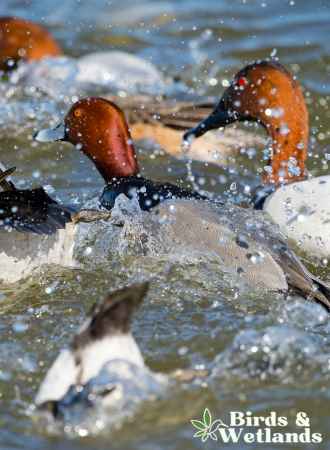
Key Points
- Redheads winter and migrate south to the southern United States, northern Mexico, the Bahamas and the Caribbean.
- Like other diving ducks, redheads are often seen foraging underwater.
- Adult males are known for their copper head and upper neck, gray body and pale blue bill.

